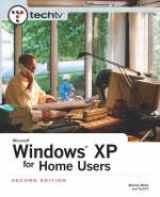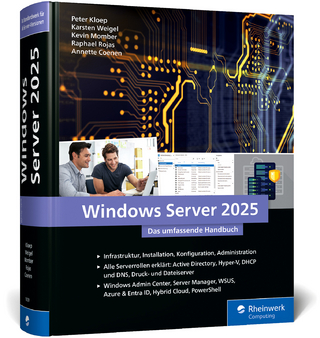
TechTV Microsoft Windows XP for Home Users
Que Corporation,U.S. (Verlag)
978-0-7897-2651-3 (ISBN)
- Titel erscheint in neuer Auflage
- Artikel merken
TechTV's Microsoft Windows XP for Home Users is written in a lighthearted and conversational style but at the core is clear, practical information. This book shows readers how to customize and configure their systems, how to prevent and fix problems, how to add hardware and software, and how to have fun with Windows XP by exploring its many features. The entertaining style makes it fun to read, but readers will come away feeling as if the have learned a lot, too. It is assumed that most readers will have this software, although someone might buy the book as an introduction to Windows XP before upgrading from an earlier version. This book focuses almost exclusively on Windows XP and how earlier versions worked differently.
TechTV's MicrosoftWindows XP for Home UsersAbout the Authors Jim Louderback is vice president and editorial director of TechTV. Louderbackis responsible for overseeing the network's technical content. Prior toTechTV, Louderback was vice president and editorial director of PC Week (noweWeek), editor-in-chief of Windows Sources, and the director of PC WeekLabs. Louderback grew up in the Northeast. He graduated from the University ofVermont, where he studied mathematics, and holds an MBA in computer applicationsfrom New York University. He is an avid outdoorsman who enjoys living on the Northern California coastwhere his favorite activities are hiking and sailing. Michael Miller is a successful and prolific author with a reputation forpractical advice and technical accuracy, and an unerring empathy for the needsof his readers. Mr. Miller has written more than three dozen how-to and reference books since1989, for Que and other major publishers. His books for Que include UsingWindows 95, Using Windows 98 Preview Edition, Special Edition Using the Internetand the Web, and the upcoming Absolute Beginner's Guide to Computers andthe Internet. He is known for his casual, easy-to-read writing style and hispractical, real-world advice—as well as his ability to explain a widevariety of complex topics to an everyday audience. Mr. Miller is also president of The Molehill Group, a strategic consultingand authoring firm based in Carmel, Indiana. As a consultant, he specializes inproviding strategic advice to and writing business plans for Internet- andtechnology-based businesses. You can e-mail Mr. Miller directly at using@molehillgroup.com. His Web site is located at http://www.molehillgroup.com. © Copyright Pearson Education. All rights reserved.
Introduction.
I. GETTING TO KNOW WINDOWS XP.
1. New Windows for Old Users: What's New, What's Changed.
What Windows XP Is-and What It Isn't. Under the Hood. Windows XP's New “Look and Feel” Features. Windows XP's New Internet Features. Windows XP's New Multiuser and Multiple-PC Features. Windows XP's New Audio and Video Features. Windows XP's New System Utilities. Windows XP's Help and Registration Features. Feature Comparison. Old Versus New: How to Do What You Used to Do. Stuff That Didn't Make the Final Cut. Jim's Top Ten Tips.
2. Changing the Way Windows Looks- and Acts.
Fine-Tuning the Display. Configuring the Desktop. Working with Desktop Shortcuts. Working with Toolbars, the Taskbar, and the System Tray. Managing the Start Menu. Changing Your Cursors. Changing Your Click. Using a Screen Saver. Changing System Sounds. Adding and Removing Fonts. Configuring Other System Settings. Even More Personalization-with Tweak UI. Making Windows XP Look Like Windows 9X/Me. Jim's Top Ten Tips.
II. WORKING WITH FILES, PROGRAMS, AND PERIPHERALS.
3. Managing Files.
Understanding Files and Folders. Windows XP's File Management Tools. Configuring File and Folder Views. Basic Navigation and Operations. Essential File Management. Compressing and Decompressing Files. Working with File Types and Associations. Jim's Top Ten Tips.
4. Running Programs.
Adding and Removing Software. Installing Programs from the Internet. Launching Programs. Launching Programs When Windows Starts. Switching Between Programs. Arranging Windows on Your Desktop. Closing Stuck Programs. Jim's Top Ten Tips.
5. Controlling Printers.
Adding and Removing Printers. Configuring Printers. Managing the Printing Process. Jim's Top Ten Tips.
6. Adding New Hardware.
Understanding Ports. Installing New Peripherals. Updating Device Drivers. Solving Device Conflicts. Most Popular Peripherals. Working with Hardware Profiles. Jim's Top Ten Tips.
III. TAKING WINDOWS ONLINE.
7. Making the Connection.
Configuring a New Account. Connecting via MSN. Understanding Broadband Internet. Sharing an Internet Connection. Activating the Firewall. Jim's Top Ten Tips.
8. Surfing the Web with Internet Explorer.
Introducing Internet Explorer 6. Personalizing the Browser Interface. Configuring the Browser. Surfing Safely. Speeding Up Your Browser. Working with Web Sites. Alternative Browsers. Jim's Top Ten Tips.
9. Sending and Receiving E-mail with Outlook Express.
Introducing Outlook Express 6. Configuring Outlook Express. Protecting Against E-mail Viruses. Sending and Receiving E-mail. Sending Fancy Messages. Connecting to Web Mail. Working with Folders and Message Rules. Using the Address Book. Using Outlook Express with Newsgroups. Alternative E-mail/Newsreader Clients. Jim's Top Ten Tips.
10. Chatting Online with Windows Messenger.
Introducing Windows Messenger. Getting Connected. Finding New Contacts. One-to-One Messaging. Group Chats. Making Internet Phone Calls. Video Conferencing. Jim's Top Ten Tips.
IV. SOUNDS AND PICTURES.
11. Working with Pictures.
Working with My Pictures. Tracking Details. Different Views. Editing Picture Files. Working with Picture Files. Jim's Top Ten Tips.
12. Working with Digital Cameras and Scanners.
Installing and Configuring a Digital Camera or Scanner. Scanning Pictures. Uploading Pictures from a Digital Camera. Working with Pictures In the Camera. Jim's Top Ten Tips.
13. Using Windows Media Player.
Understanding Digital Media Files. Introducing Windows Media Player. Configuring WMP. Playing Audio Files. Listening to Internet Radio. Watching DVDs. Organizing Your Media Files. Using Other Media Players. Jim's Top Ten Tips.
14. Playing and Recording MP3 and WMA Audio.
Introducing Digital Audio. Finding and Downloading Digital Audio Files. Copying (Ripping) CD Tracks to Your PC. Burning Audio Files to a CD. Other Rippers and Burners. Jim's Top Ten Tips.
15. Playing and Editing Digital Movies.
Introducing Windows Movie Maker. Assembling Your Source Material. Editing Your Video. Saving Your Movie. Jim's Top Ten Tips.
V. IN THE HOME AND ON THE ROAD.
16. Working with Multiple Users.
Planning for Multiple Users. Types of Users. Setting Up New Users. Editing User Settings. Switching Users. Sharing-or Not Sharing-Files and Folders. Jim's Top Ten Tips.
17. Playing Games.
Installing and Configuring Game Controllers. Building a Better Gaming System. Embracing DirectX. Troubleshooting Game Problems. Jim's Top Ten Tips.
18. Setting Up a Home or Small Business Network.
Understanding Different Types of Networks. Setting Up Your Network. Running the Network Setup Wizard. Setting Up Network Sharing. Accessing Files, Printers, and Other Computers on Your Network. Jim's Top Ten Tips.
19. Using Windows XP on Portable PCs.
Improving Your Display with ClearType. Optimizing Battery Life. Connecting Two PCs with a Direct Network Connection. Controlling Another Computer with Remote Desktop Connection. Using Briefcase to Synchronize Files. Working with Offline Files. Jim's Top Ten Tips.
VI. MAINTENANCE AND TROUBLESHOOTING.
20. Getting Help.
Introducing Windows XP's New Help and Support Center. Finding More Help Online. Getting Remote Assistance. Jim's Top Ten Tips.
21. Updating Windows.
Picking and Choosing Windows Components. Downloading and Extracting Device Drivers. Updating Windows Online. Transferring Files and Settings. Creating an Emergency Startup Disk- or Not. Jim's Top Ten Tips.
22. Keeping Windows Healthy and Happy.
Cleaning Up Unnecessary Files. Defragging Your Disk. Performing a Hard Disk Checkup with ScanDisk. Viewing System Performance. Viewing More System Information. Displaying Key System Properties. Managing Your Devices. Accessing More System Information- and Utilities. Scheduling Your Maintenance. Backing Up and Restoring Critical Files. Managing the Windows Registry. Jim's Top Ten Tips.
23. Recovering from System Crashes.
Starting in Safe Mode. Tracking Down Problems with the System Configuration Utility. Undoing Something Bad with System Restore. Avoiding and Recovering from Computer Viruses. Jim's Top Ten Tips.
24. Troubleshooting Common Problems.
Basic Troubleshooting Tips. Troubleshooting Technical Problems with Technical Tools. Simple Solutions to Common Problems. Jim's Top Ten Tips.
VII. APPENDIXES.
Appendix A. Upgrading to Windows XP.
The Typical Upgrade Installation. The “Clean” Installation. Activating and Registering Windows. Uninstalling Windows XP.
Appendix B. Windows Accessories.
Calculator. Character Map. Clipboard Viewer. Games. HyperTerminal. Notepad. Paint. Sound Recorder. WordPad.
Appendix C. Accessibility Options.
Control Panel Accessibility Options. Other Accessibility Tools. Using the Accessibility Wizard.
Appendix D. A Tour of TechTV.
Audience. Web Site. International. Tech Live Quick Facts. Network Program Guide.
Index.
| Erscheint lt. Verlag | 2.11.2001 |
|---|---|
| Sprache | englisch |
| Maße | 188 x 231 mm |
| Gewicht | 786 g |
| Themenwelt | Informatik ► Betriebssysteme / Server ► Windows |
| ISBN-10 | 0-7897-2651-3 / 0789726513 |
| ISBN-13 | 978-0-7897-2651-3 / 9780789726513 |
| Zustand | Neuware |
| Informationen gemäß Produktsicherheitsverordnung (GPSR) | |
| Haben Sie eine Frage zum Produkt? |
aus dem Bereich



